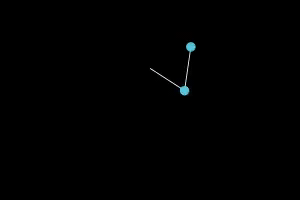A new kind of laboratory
In a nutshell, Filestack Labs is a space for showcasing unconventional software projects. The core idea is to explore the possibilities of using computers to help us think about the overlapping features of science, art, and engineering. To narrow it down, let’s define a set of recursive relations between those three fields in a way that may seem self-contradictory but captures well the ambition of what Filestack Labs is supposed to be:
1. science rather than engineering
2. engineering rather than art
3. art rather than science (go back to 1.)
Those rules create what Douglas Hofstadter calls a “strange loop”1 - an ambiguous hierarchy that can generate creative tension. Every project realized inside Filestack Labs is set to interact with that tension and bring about a blend of engineering, art, and science.
Art
Computers go hand in hand with many facets of art, although usually in the role of the low-level tools used to craft the artist’s work. Hence, computer animation and “visual effects” are a massive part of the movie industry, just as sound-producing software and the infinitude of digital synthesizers are a part of the music business.
But there is also a lot of art where some algorithm or a mathematical structure is the central piece - the Mandelbrot set has to be the best-known example, but a lot of experimentation is happening in that space all the time2. Along those lines, algorithmic music composition is a challenge that has yet to see a solution with aesthetic impact comparable to primarily human-generated music. One of the central motivators of Filestack Labs is to explore mathematical models that operate on musical building blocks - either to look for what sounds good or to use sound as a data presentation utility3.
Science
Richard Feynman had a rant once4 about the fact that scientific knowledge does not subtract from the beauty of nature, but on the contrary, enriches it with additional levels of appreciation. Looking for scientific points of view that unveil those levels of appreciation is also a high priority for Filestack Labs. Anything that can be measured, modeled or simulated, and then decomposed statistically is of high interest here. And it doesn’t matter if we’re pondering an age-old question like “why does the sun shine”5 or trying to figure out a pipeline for training neural networks on a set of Bach’s cantatas.
Engineering
In the realm of computation, nothing can be achieved without a considerable engineering effort, and that’s true for Filestack Labs’ projects as well. Most of that work consists of building tools that we need to build other tools that we need. This is a rewarding process, especially when those tools actually work.
About the author
Up to this point, this is a one-person operation. It all started ten years ago while I was a physics student at one of the academic institutions in Poland. For reasons unbeknownst to me, I’ve developed a peculiar fixation with double pendulums6 and the idea of translating their beautiful and chaotic movement into a beautiful and chaotic musical experience. I guess what drew me in was the promise of finding a path from a purely mathematical concept of deterministic chaos to the aesthetic experience I had watching the intricate dance of a double pendulum.
This idea took me on a journey of learning software engineering, sound processing, and numerical simulations. The final result consisted of a couple of YouTube videos about “double pendulum sonification”7. To my horror, I realized that this line of work had a very limited monetary potential. It would appear that all silicon valley companies already had people trying to figure out how to make chaotic systems compose flute music and were not hiring for those departments. By good fortune, the same skillset is just right for most of the excellent data-science positions. So, after being entirely disenchanted by career opportunities in physics8, my python skills took me through a couple of awesome commercial projects to my last position as a “machine learning developer” at Filestack.
And now the time has come to get back to the computational exploration of engineering, science, and art. So, with a swift intra-company maneuver, I transitioned into a creative-software position of running Filestack Labs. It is now a home base for my projects where I document both the results and the process.
If you have any questions, comments, or maybe a rebuke, you can reach me here:
- Tomek
-
Twitter is a great way to find algorithmic art. Here are some noteworthy examples: ↩︎
-
Check out the ECG Sonification post or some videos with my previous work: three-body problem sonification and mathematical curves music. ↩︎
-
Here’s his flower monologue. ↩︎
-
There is an animated exploration of that question already on Filestack Labs: How old is the sunlight? ↩︎
-
The double pendulum is widely used as an example of a chaotic system that can be described by simple physics. ↩︎
-
You can still watch all of them! This is my favorite pendulum video. There are also other videos in the same spirit. ↩︎
-
I fell into the trap of pondering the non-probabilistic models of quantum mechanics. Fascinating topic, zero funding whatsoever. ↩︎

